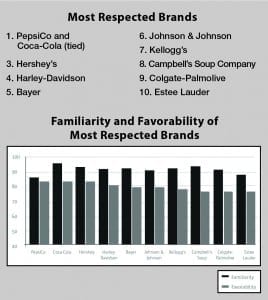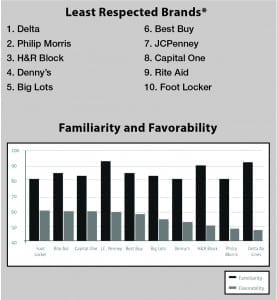*These 10 brands do not represent the least favorable brands that CoreBrand tracks; they do represent the companies that are least favorable among the most widely familiar brands.
More than two-thirds of the top 10 most respected brands in 2013 hailed from the consumer staples sector, per CoreBrand.That’s not exactly surprising when you consider that the category tends to fare the best during tough economic times.
At the same time, the brands share another and perhaps more salient trait in common: a familiarity score hovering in the 80s to mid-90s. A score in that vicinity has near universal awareness, with some level of confidence about the full breadth of the business, according to the report.
BrandPower Series: Brand Respect stems from the 2013 version of CoreBrand’s Corporate Branding Index, which is based on a continuous benchmarking tracking survey of 1,000 companies across 54 industries and 10 business sectors.
While the most respected brands tend to be the bigger companies, they take a decidedly holistic approach to communications. “These companies tend to communicate more, whether that’s through advertising, PR, IR or social media,” said Jim Gregory, CEO of CoreBrand. “And they’re spending more time trying to communicate and message on all the [media] platforms.”
As brands distribute their messages more and more via myriad channels, the trick for communicators is to make sure the messages are consistent.
“Every company has multiple audiences to reach,” Gregory said. The various messages have “to be woven into a consistent theme and a consistent plan. The more consistency from brands, the more favorability” they garner. PRN
CONTACT:
Jim Gregory, [email protected].


